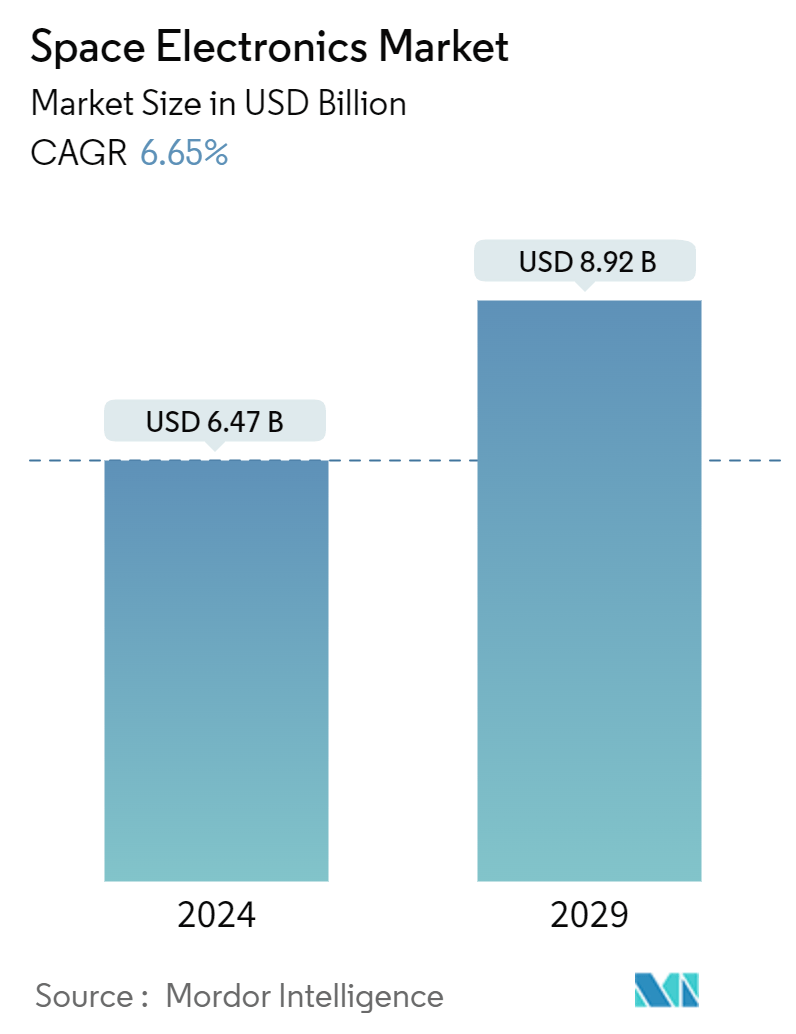Market Size of Space Electronics Industry

| Study Period | 2019 - 2029 |
| Market Size (2024) | USD 6.47 Billion |
| Market Size (2029) | USD 8.92 Billion |
| CAGR (2024 - 2029) | 6.65 % |
| Fastest Growing Market | Asia Pacific |
| Largest Market | Asia Pacific |
| Market Concentration | Low |
Major Players
*Disclaimer: Major Players sorted in no particular order |
Space Electronics Market Analysis
The Space Electronics Market size is estimated at USD 6.47 billion in 2024, and is expected to reach USD 8.92 billion by 2029, growing at a CAGR of 6.65% during the forecast period (2024-2029).
The space electronics market is witnessing robust growth, propelled by increased satellite launches, escalating investments in the space sector, and a global push for enhanced communication and navigation. Notably, the space sector is witnessing a surge in investments, with a rising appetite for ventures like interplanetary exploration and potential space mining, further fueling the market expansion.
Moreover, the rising adoption of geospatial systems for heightened surveillance and quicker response times, coupled with advancements in microelectronics, is pivotal. These advancements enable the development of sophisticated space-based systems with advanced features while driving down associated research and development costs.
As satellites find an expanding array of applications from surveillance and navigation to weather forecasting, bolstering network connectivity, and even integrating IoTs across commercial, governmental, and civil-military sectors, and the market is presented with ample growth opportunities.
The market faces hurdles in the form of high design and development costs for space-based electronics, alongside the complexity of creating realistic testing environments.
Space Electronics Industry Segmentation
Space electronics encompasses electronic components, systems, and equipment tailored for space missions. These technologies are engineered to endure the harsh conditions of space, such as radiation, vacuum, temperature fluctuations, and mechanical strains.
The space electronics market is segmented by platform, application, type, and geography. By platform, the market is segmented into satellites, launch vehicles, and deep space probes. By application, the market is segmented into communication, earth observation, navigation and surveillance, technology development and education, and other applications. By type, the market is segmented into radiation-hardened and radiation-tolerant. The report also covers the market sizes and forecasts for the space electronics market in major countries across different regions. The market size is provided for each segment in terms of value (USD).
| By Platform | |
| Satellite | |
| Launch Vehicles | |
| Deep Space Probes |
| By Application | |
| Communication | |
| Earth Observation | |
| Navigation and Surveillance | |
| Technology Development and Education | |
| Other Applications |
| By Type | |
| Radiation-hardened | |
| Radiation-tolerant |
| Geography | |||||||
| |||||||
| |||||||
| |||||||
| |||||||
|
Space Electronics Market Size Summary
The space electronics market is experiencing significant growth, driven by an increase in satellite launches and investments in the space sector. This growth is further fueled by a global emphasis on enhancing communication and navigation capabilities, as well as ventures into interplanetary exploration and potential space mining. The market is benefiting from advancements in microelectronics, which enable the development of sophisticated space-based systems with advanced features while reducing research and development costs. The expanding applications of satellites, ranging from surveillance and navigation to weather forecasting and IoT integration, present ample growth opportunities. However, the market faces challenges such as high design and development costs and the complexity of creating realistic testing environments.
The satellite segment has emerged as the largest market share holder, supported by a rising number of satellite launches and the increasing reliance on satellite data across various industries. Countries like the United States, China, Russia, the United Kingdom, Japan, India, Canada, Germany, and Luxembourg are leading in satellite industry advancements. The market is also witnessing a shift towards nano and microsatellites, particularly in the military domain, as armed forces seek smaller and less vulnerable options. Prominent players in the market, such as Cobham Limited, Microchip Technology Inc., BAE Systems PLC, STMicroelectronics NV, and Honeywell International Inc., are focusing on advanced electronic systems for space missions. These companies, along with smaller specialized firms, are driving market growth through technological progress, a rising appetite for satellites, and robust government support for space exploration and national security.
Space Electronics Market Size - Table of Contents
-
1. MARKET DYNAMICS
-
1.1 Market Overview
-
1.2 Market Drivers
-
1.3 Market Restraints
-
1.4 Porter's Five Forces Analysis
-
1.4.1 Threat of New Entrants
-
1.4.2 Bargaining Power of Buyers/Consumers
-
1.4.3 Bargaining Power of Suppliers
-
1.4.4 Threat of Substitute Products
-
1.4.5 Intensity of Competitive Rivalry
-
-
-
2. MARKET SEGMENTATION
-
2.1 By Platform
-
2.1.1 Satellite
-
2.1.2 Launch Vehicles
-
2.1.3 Deep Space Probes
-
-
2.2 By Application
-
2.2.1 Communication
-
2.2.2 Earth Observation
-
2.2.3 Navigation and Surveillance
-
2.2.4 Technology Development and Education
-
2.2.5 Other Applications
-
-
2.3 By Type
-
2.3.1 Radiation-hardened
-
2.3.2 Radiation-tolerant
-
-
2.4 Geography
-
2.4.1 North America
-
2.4.1.1 United States
-
2.4.1.2 Canada
-
-
2.4.2 Europe
-
2.4.2.1 United Kingdom
-
2.4.2.2 Germany
-
2.4.2.3 France
-
2.4.2.4 Russia
-
2.4.2.5 Rest of Europe
-
-
2.4.3 Asia-Pacific
-
2.4.3.1 India
-
2.4.3.2 China
-
2.4.3.3 Japan
-
2.4.3.4 South Korea
-
2.4.3.5 Rest of Asia-Pacific
-
-
2.4.4 Latin America
-
2.4.4.1 Brazil
-
2.4.4.2 Rest of Latin America
-
-
2.4.5 Middle East and Africa
-
2.4.5.1 United Arab Emirates
-
2.4.5.2 Saudi Arabia
-
2.4.5.3 Israel
-
2.4.5.4 Rest of Middle East and Africa
-
-
-
Space Electronics Market Size FAQs
How big is the Space Electronics Market?
The Space Electronics Market size is expected to reach USD 6.47 billion in 2024 and grow at a CAGR of 6.65% to reach USD 8.92 billion by 2029.
What is the current Space Electronics Market size?
In 2024, the Space Electronics Market size is expected to reach USD 6.47 billion.

